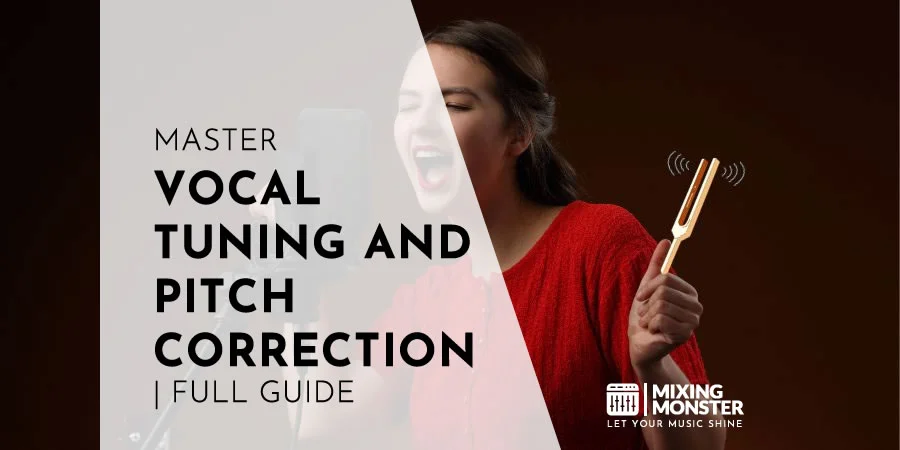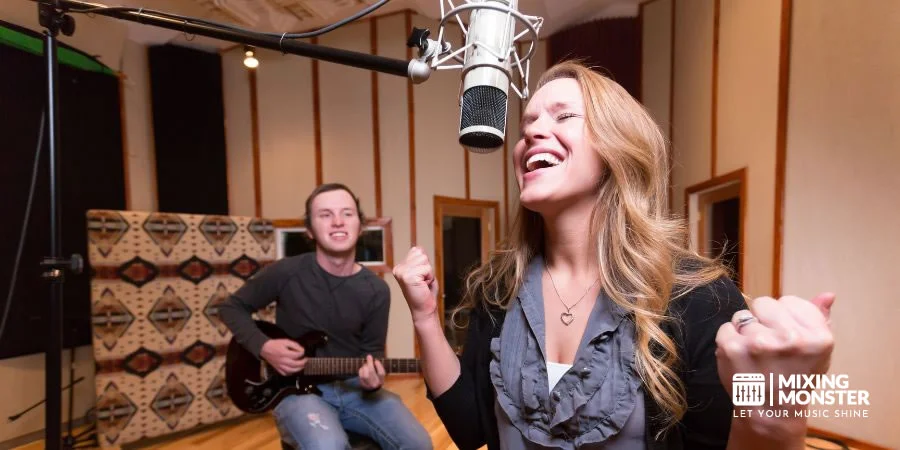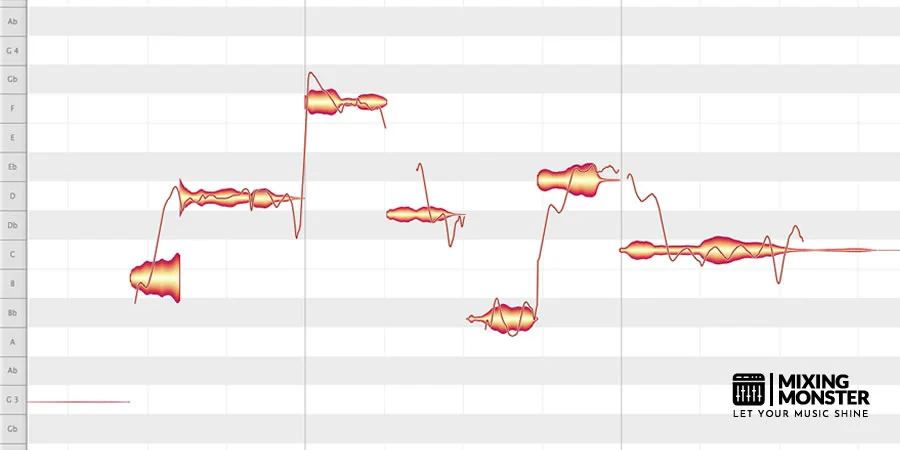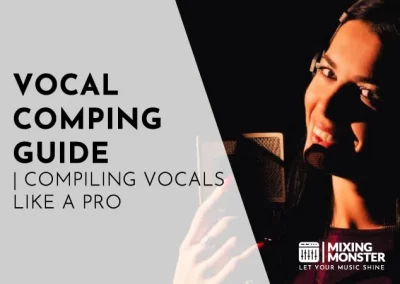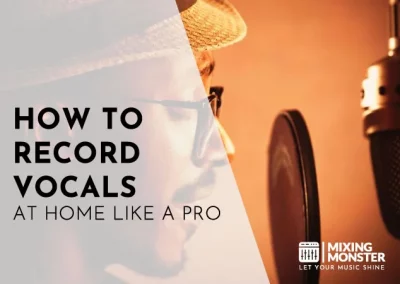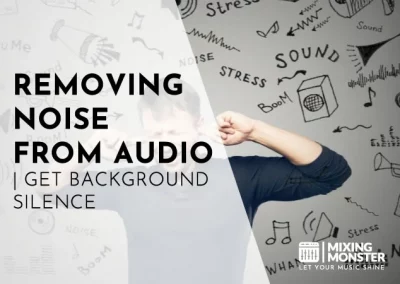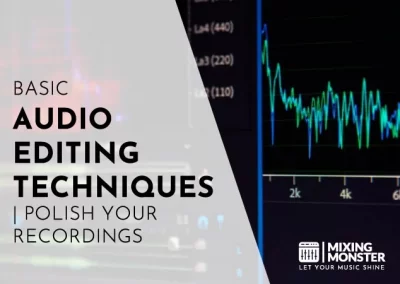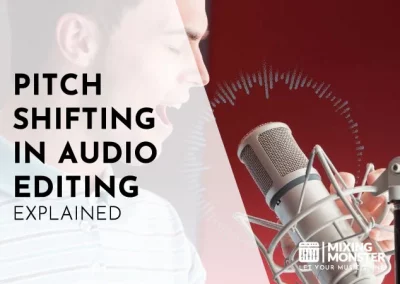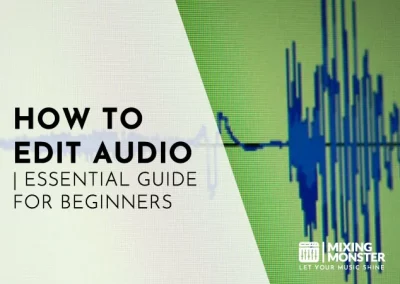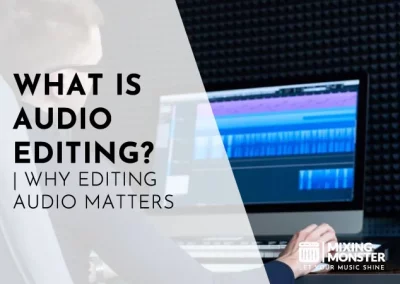Home > Blog > Editing > Editing Techniques
Affiliate Disclaimer: We may earn a commission if you purchase through our links
Vocal tuning and pitch correction are essential in the modern music production toolkit. These techniques have become more sophisticated and accessible, offering a range of possibilities from subtle pitch adjustments to dramatic vocal transformations. Whether you’re a seasoned audio engineer or a budding musician, understanding how to master vocal tuning can significantly enhance your audio production quality.
Vocal tuning and pitch correction involve adjusting a singer’s pitch to achieve perfect harmony and tone. Predominantly done using software like Auto-Tune, it corrects off-key inaccuracies, enhances performance, and can also be used creatively to add unique effects to vocals.
From fine-tuning natural vocal nuances to experimenting with creative sound effects, these techniques can transform ordinary recordings into extraordinary masterpieces. Dive deeper into the intricacies of vocal tuning to craft clear, dynamic, and pleasing vocals!
Table Of Contents
1. Vocal Tuning In Modern Music
2. Understanding Vocal Tuning And Pitch Correction
3. The Necessity Of Vocal Tuning In Audio Engineering
4. Step-By-Step Guide To Vocal Tuning
5. Exploring Vocal Tuning Software
6. Manual Vocal Tuning: Techniques And Tips
7. The Limits And Possibilities Of Vocal Tuning
8. Best Practices And Common Mistakes In Vocal Tuning
9. The Future Of Vocal Tuning In Audio Production
10. FAQ

1. Vocal Tuning In Modern Music
The advent and evolution of vocal tuning have significantly shaped the world of modern music. This technique, a staple in audio production, enhances a song’s overall sound quality and appeal.
At its core, vocal tuning involves adjusting the pitch of a singer’s voice to ensure perfect harmony and tone. Its importance in today’s music scene cannot be overstated, as it contributes to the polished, professional sound that listeners have come to expect.
The Basics Of Vocal Tuning
Vocal tuning starts with the fundamental concept of pitch correction. It involves adjusting slightly off-key vocals, ensuring each note perfectly aligns with the intended musical scale.
This not only improves the technical quality of a recording but also elevates the emotional impact of the performance.
The Importance Of Vocal Tuning In Modern Music
The necessity of vocal tuning in contemporary music production stems from its ability to transform an average vocal performance into something extraordinary.
It’s not just about fixing errors; it’s about enhancing the natural beauty of the voice and giving artists the confidence to experiment with their vocal range without fear of imperfection.
The Rise Of Auto-Tune And Similar Vocal Tuning Software
Since its introduction, Auto-Tune has become synonymous with vocal tuning. This software, along with its counterparts, has revolutionized the way producers and artists approach vocal recording.
From subtle corrections to distinct vocal effects, these tools offer a range of functionalities that cater to various artistic needs.
2. Understanding Vocal Tuning And Pitch Correction
Vocal tuning and pitch correction are two cornerstones of contemporary audio engineering, each playing a unique role in music production. While they are often used interchangeably, subtle differences distinguish them.
Defining Vocal Tuning
Vocal tuning refers explicitly to adjusting the pitch of a singer’s voice to ensure it aligns precisely with the intended musical notes. This technique is crucial for creating a harmonious and pleasing sound, especially in professional recordings where even minor pitch deviations can be noticeable.
Explaining Pitch Correction
Pitch correction, on the other hand, is a broader term encompassing vocal tuning and correcting instrumental notes. It’s a process used to manually correct any off-pitch notes to their nearest correct pitch or through software. This ensures a cleaner, more harmonious blend of sounds in a track.
Vocal Tuning Vs. Pitch Correction: Key Differences
The main difference lies in their application scope. Vocal tuning focuses exclusively on the human voice, while pitch correction can be applied to any musical element.
Additionally, vocal tuning often involves more detailed adjustments to maintain the natural qualities and expressiveness of the singer’s voice. At the same time, pitch correction might be more straightforward, focusing simply on aligning pitches correctly.
3. The Necessity Of Vocal Tuning In Audio Engineering
Vocal tuning has become an indispensable part of audio engineering, playing a crucial role in shaping the sound and quality of modern music.
Enhancing Vocal Performance With Vocal Tuning
The primary purpose of vocal tuning is to enhance vocal performances. Even the most skilled singers occasionally hit a note slightly off-pitch, especially during complex or emotionally charged performances.
Vocal tuning gently corrects these imperfections, ensuring the final output is pitch-perfect. This not only elevates the quality of the recording but also allows singers to deliver their best performances without the pressure of absolute pitch accuracy.
Correcting Off-Key Notes In Vocals
Another critical aspect of vocal tuning is the correction of off-key notes. This is particularly important in professional recordings where even slight pitch deviations can be noticeable and potentially distracting.
Vocal tuning ensures that each note perfectly harmonizes with the rest of the track, contributing to a cohesive and pleasing listening experience.
Maintaining Artistic Integrity While Tuning Vocals
A significant consideration in vocal tuning is maintaining the artist’s unique vocal qualities. While correcting pitch inaccuracies is vital, over-tuning can strip away the voice’s natural character and emotional expression.
The goal is to find a balance where the tuning is sufficient to enhance the performance without compromising the authenticity and artistic integrity of the singer’s voice.
4. Step-By-Step Guide To Vocal Tuning
Recording Vocals For Optimal Tuning
A pristine vocal recording is paramount for effective tuning. This involves using a high-quality microphone, ensuring an acoustically treated recording environment, keeping physical effects in mind, like the proximity effect, and capturing the best possible performance from the artist.
A clear and clean recording forms the ideal foundation for any vocal tuning work. In other words, a poorly recorded voice and/or bad vocal performance is a suboptimal place to start.
Selecting The Right Vocal Tuning Software
The selection of vocal tuning software is critical. Options range from the popular Auto-Tune to alternatives like Melodyne and Waves Tune. Considerations include the software’s features, ease of use, and compatibility with your Digital Audio Workstation (DAW).
The Process Of Tuning Vocals
- Preparing The Vocal Track:
Import the raw vocal track into your DAW. Ensure it’s isolated from other instruments for more precise analysis and adjustments. - Setting Key And Scale:
Identify the key and scale of the song. This is crucial for the tuning software to apply correct pitch corrections. Use tools within your DAW or the tuning software to detect the key if it is uncertain. - Initial Listening Session:
Listen to the track thoroughly to identify sections that require tuning. Take notes of specific parts that need attention. - Applying Automatic Tuning (if applicable):
Use automatic tuning settings for quick adjustments. This is suitable for minor corrections. - Manual Corrections:
For more precise control, switch to manual mode. Zoom in on the waveform and manually adjust the pitches of individual notes. Pay attention to the start and end points of notes, as these are common areas for pitch drifts. - Adjusting Note Transitions:
Ensure smooth transitions between notes. Abrupt jumps can sound unnatural. Tools like ‘glide’ or ‘transition’ smooth out these changes. - Retaining Natural Vibrato:
Be cautious with vibrato. Over-correcting can make a voice sound robotic. Adjust settings to maintain the singer’s natural vibrato while correcting pitch. - Tweak Timing (If Needed):
Some software allows for timing adjustments. Use this feature sparingly to align notes with the rhythm, especially in significant timing issues. - Final Listening And Adjustment:
After making corrections, listen to the track multiple times. Make final adjustments to ensure naturalness and musicality. - Comparison With Original:
Finally, compare the tuned version with the original recording to ensure the essence of the performance is intact and the changes made serve the song effectively.

5. Exploring Vocal Tuning Software
In the realm of vocal tuning, the choice of software is crucial. This section explores the various vocal tuning tools available, their features, and how to choose the right one for your needs.
Overview Of Popular Vocal Tuning Tools
There are several vocal tuning software options available, each with its unique set of features and capabilities. Some of the most popular include:
- Auto-Tune:
Known for its ease of use and the iconic ‘Auto-Tune effect,’ it’s a favorite in professional and home studios. - Melodyne:
Praised for its ability to manipulate pitch, time, and even the timbre of vocals with incredible precision. - Waves Tune:
Offers real-time pitch correction and is celebrated for its natural-sounding results.
Vocal Tuning Software Features And Capabilities
When assessing vocal tuning software, consider the following basic features:
- Pitch Correction Quality:
How naturally and accurately the software corrects pitch. - Flexibility:
The ability to make both subtle adjustments and dramatic alterations. - User Interface:
How intuitive and user-friendly (GUI) is the software? - Compatibility:
Ensure the software is compatible with your existing DAW and operating system. Consider updates and support as well.
Choosing The Right Vocal Tuning Tool For Your Needs
The choice of software should align with your specific needs:
- Skill Level:
Beginners may prefer software with a more straightforward interface, while professionals might opt for more advanced features. - Project Requirements:
Consider the level of correction needed and whether the project calls for a natural sound or a distinct Auto-Tune effect. - Budget:
Software ranges from affordable to professional-grade pricing. Determine your budget and find the best option within that range.
Comparison List Of Vocal Tuning Software Features
| Software | Ease of Use | Real-Time Correction | Pitch & Time Manipulation | Advanced Editing |
| Auto-Tune | High | Yes | Basic | Moderate |
| Melodyne | Moderate | No | Advanced | High |
| Waves Tune | Moderate | Yes | Basic | Moderate |
| Logic Pro Flex Pitch | High | No | Advanced | High |
| Celemony Capstan | Low | No | Advanced | High |
| Antares AVOX | Moderate | Yes | Moderate | Moderate |
| Synchro Arts Revoice Pro | Moderate | No | Advanced | High |
| iZotope Nectar | High | Yes | Moderate | High |
| TC Helicon VoiceLive | High | Yes | Basic | Basic |
6. Manual Vocal Tuning: Techniques And Tips
While software plays a significant role in vocal tuning, manual tuning skills are invaluable for achieving the most natural and expressive vocal quality. This section delves into the art of manual vocal tuning.
The Art Of Manual Vocal Tuning
Manual vocal tuning involves meticulously adjusting each note by ear and is often preferred for its ability to preserve the natural characteristics of the voice. It requires a keen ear for pitch and a deep understanding of vocal techniques.
Best Practices For Manual Vocal Correction
- Ear Training:
Develop a keen ear for detecting even slight pitch deviations. This skill is crucial for effective manual tuning. - Subtle Adjustments:
Make small, incremental changes. The goal is to correct the pitch without altering the vocal’s natural expression. - Preserving Emotion:
Be mindful of the emotional intent of the performance. Over-tuning can strip away the emotional impact of the vocals. - Consistency:
Ensure the tuning is consistent throughout the track. Abrupt changes in vocal quality can be jarring to listeners.
When To Choose Manual Over Automated Vocal Tuning
Manual tuning is often the preferred choice when working with:
- Complex vocal performances that require nuanced adjustments.
- Genres where natural vocal expression is paramount.
- Vocals that need specific stylistic treatments are not achievable through automated software.
7. The Limits And Possibilities Of Vocal Tuning
Vocal tuning, while a powerful tool in audio engineering, comes with limitations and creative possibilities. Understanding these can help in maximizing its potential while respecting artistic integrity.
Understanding The Boundaries Of Vocal Tuning
Recognizing the limits of vocal tuning is crucial:
- Maintaining Vocal Character:
Excessive tuning can result in losing the singer’s unique vocal character, leading to a synthetic sound. - Technical Limits:
There’s a threshold to how much a pitch can be altered before it starts sounding unnatural or distorted. - Artistic Authenticity:
Over-reliance on tuning can mask a singer’s actual ability, raising questions about authenticity in live performances.
Creative Uses Of Vocal Tuning
Beyond correction, vocal tuning can be creatively used:
- Stylistic Effects:
Artists in genres like pop and electronic music often use vocal tuning for stylistic effects, creating a distinctive sound. - Harmonic Layering:
Tuning can create harmonized vocal layers, adding depth and richness to a track. - Experimental Sounds:
Some artists experiment with extreme tuning for avant-garde or experimental music pieces.
8. Best Practices And Common Mistakes In Vocal Tuning
Achieving the best results in vocal tuning involves adhering to certain best practices while avoiding common pitfalls. This section aims to guide both.
Best Practices In Vocal Tuning
- Naturalness Is Key:
Strive for a balance where the tuning corrects pitch without compromising the natural quality of the voice. - Contextual Tuning:
Consider the genre, song style, and artist’s intent. Tuning should be tailored to fit the context of the track. - Gradual Adjustments:
Make incremental, minor adjustments. Sudden, significant changes can make the vocals sound artificial. - Regular Breaks:
Take breaks during tuning to prevent ear fatigue, which can lead to over or under-tuning.
Common Mistakes In Vocal Tuning
- Over-Tuning:
Excessive correction that leads to an unnatural, robotic sound. - Ignoring Emotional Content:
Focusing solely on pitch perfection at the expense of the emotional expression in the vocals. - Inconsistent Tuning:
The application of tuning across different parts of the track leads to an uneven vocal performance. - Neglecting Timing:
Focusing only on the pitch and neglecting the timing aspects can result in a performance that feels out of sync with the music.
Keeping The Natural Essence Of The Voice
The ultimate goal of vocal tuning is to enhance the performance without losing the essence of the artist’s voice. A well-tuned vocal track should sound polished yet retain the emotional and expressive qualities of the original performance.
9. The Future Of Vocal Tuning In Audio Production
The landscape of vocal tuning is constantly evolving, influenced by technological advancements and changing musical trends. This section explores the potential future developments in this field.
Evolving Trends And Techniques In Vocal Tuning
- Advancements in AI and Machine Learning:
Future vocal tuning software may leverage AI to make more accurate and natural-sounding adjustments, potentially streamlining the tuning process. - Increased Accessibility:
As technology advances, high-quality vocal tuning tools may become more accessible to independent artists and home studios. - Integration with Emerging Technologies:
We might see the integration of vocal tuning with emerging technologies like virtual reality (VR) and augmented reality (AR), offering new ways to experience and manipulate sound.
The Role Of Vocal Tuning In Future Music
Vocal tuning will likely continue to play a significant role in music production:
- Shaping Musical Styles:
It will continue influencing various musical genres, possibly developing new styles and artistic expressions. - Balancing Artistry and Technology:
The ongoing challenge will be finding the balance between technological capability and artistic integrity, ensuring that vocal tuning enhances rather than overshadows the human element in music. - Ethical Considerations:
As vocal tuning becomes more sophisticated, discussions around its ethical use, especially regarding authenticity in music, will likely become more prevalent.
Vocal Tuning: Enhancing, Not Just Repairing
Vocal tuning is an art that, when used wisely, enhances the natural beauty of a recording rather than merely serving as a tool for repair. It’s about elevating good vocal performances to greatness, not masking flaws.
By focusing on enhancing what’s already there, vocal tuning can bring out the best in performance, adding polish and professionalism without losing the authenticity and emotion that make music truly resonate.
Happy tuning!
10. FAQ
- What Is Vocal Tuning?
Vocal tuning is the process of adjusting the pitch of a singer’s voice in a recording to ensure it aligns with the correct musical notes. It’s used to correct off-key notes and enhance the overall sound quality of the vocals. - How Does Auto-Tune Work?
Auto-Tune is a software for vocal tuning that automatically detects and corrects pitch inaccuracies in vocal performances. It can be set to work automatically or allow for manual adjustments, providing flexibility in applying the tuning. - Can Vocal Tuning Be Done Manually?
Vocal tuning can be done manually, carefully adjusting each note by ear. This method is often preferred for its ability to maintain the natural quality and expression of the vocals. - How To Choose The Right Vocal Tuning Software?
When choosing vocal tuning software, consider factors like ease of use, compatibility with your recording setup, level of control, and specific project requirements. Popular choices include Auto-Tune, Melodyne, and Waves Tune. - What Are Essential Steps In Vocal Tuning?
The essential steps in vocal tuning include:
-
- Recording high-quality vocals.
- Choosing the appropriate software.
- Setting the key and scale of the song.
- Making manual or automatic pitch adjustments.
- Ensuring that the tuning enhances the performance without compromising its natural quality.

